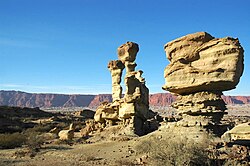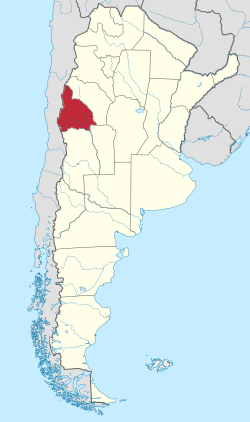
Back سان خوان (محافظة) Arabic San Juan jisk'a suyu Aymara سن خوآن ایالتی (آرژانتین) AZB San Chuana provincėjė BAT-SMG Сан-Хуан (правінцыя) Byelorussian Сан Хуан (провинция на Аржентина) Bulgarian Proviñs San Juan (Arc'hantina) Breton Província de San Juan Catalan Provincia de San Juan (lalawigan sa Argentina) CEB San Juan (argentinská provincie) Czech
This article needs additional citations for verification. (March 2013) |
San Juan | |
|---|---|
| Province of San Juan Provincia de San Juan (Spanish) | |
 | |
|
| |
 Location of San Juan within Argentina | |
| Coordinates: 30°52′S 68°59′W / 30.87°S 68.98°W | |
| Country | Argentina |
| Capital | San Juan |
| Departments | 19 |
| Districts | 100 |
| Government | |
| • Governor | Marcelo Orrego (JxC) |
| • National Deputies | 6 |
| • National Senators | 3 |
| Area | |
| • Total | 89,651 km2 (34,614 sq mi) |
| Population (2022 census[1]) | |
| • Total | 818,234 |
| • Rank | 13th |
| • Density | 9.1/km2 (24/sq mi) |
| Demonym | sanjuanino |
| GDP | |
| • Total | peso 175 billion (US$6.7 billion) (2018)[2] |
| Time zone | UTC−3 (ART) |
| ISO 3166 code | AR-J |
| HDI (2021) | 0.838 very high (19th)[3] |
| Website | sanjuan |
San Juan Province (Spanish pronunciation: [saŋ ˈxwan]) is a province of Argentina, located in the western part of the country. Neighbouring provinces are, moving clockwise from the north, La Rioja, San Luis and Mendoza. It borders with Chile to the west.
The province has an area of 89,651 km2, covering a mountainous region with scarce vegetation, fertile oases and turbulent rivers. Throughout the entire province there are an important number of paleontological sites.
Similar to other regions in Argentina, agriculture is one of the most important economic activities, highlighting wine production and olive oil. Additionally, a variety of fruits and vegetables are produced in the fertile valleys irrigated by artificial channels in the western part, close to the Andes mountain range. This is the second province in volume of wine production at the national level and in South America, and possesses outstanding varietal wines. It is also an important center of mining and oil production.
- ^ "Nuevos datos provisorios del Censo 2022: Argentina tiene 46.044.703 habitantes". Infobae. 31 January 2023. Retrieved 3 February 2023.
- ^ "PBG San Juan 2018" (PDF).
- ^ "El mapa del desarrollo humano en Argentina" (PDF). United Nations Development Programme. 25 June 2023.


